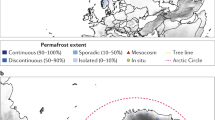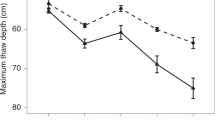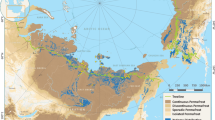Abstract
Nitrous oxide is a potent greenhouse gas whose concentration is increasing in the atmosphere1. So far, the highest terrestrial nitrous oxide emissions have been measured in agricultural and tropical soils2,3, and nitrous oxide emissions from northern natural soils have been considered negligible4,5. Pristine tundra, one of the largest natural land cover types in the world, is a mosaic of different surface types including bare surfaces created by cryoturbation6,7. Here we used a static chamber method to measure nitrous oxide emissions from the discontinuous permafrost zone in subarctic East European tundra. We show that nitrous oxide emissions from bare peat surfaces in the region, known as peat circles, range between 0.9 and 1.4 g nitrous oxide m−2 from June to October, and are equivalent to those from tropical and agricultural soils. Extrapolation of our data to the whole Arctic reveals that the emissions from these hot spots could amount to ∼0.1 Tg nitrous oxide yr−1, corresponding to 4% of the global warming potential of Arctic methane emissions at present. Therefore, not only carbon, but also nitrogen stored in permafrost soils, has to be considered when assessing the present and future climatic impact of tundra.
This is a preview of subscription content, access via your institution
Access options
Subscribe to this journal
Receive 12 print issues and online access
$259.00 per year
only $21.58 per issue
Buy this article
- Purchase on Springer Link
- Instant access to full article PDF
Prices may be subject to local taxes which are calculated during checkout



Similar content being viewed by others
References
Intergovernmental Panel on Climate Change (IPCC).in Climate Change 2007: The Physical Science Basis (eds Solomon, S et al.) (Cambridge Univ. Press, 2007).
Kroeze, C., Mosier, A. & Bouwman, L. Closing the global N2O budget: A retrospective analysis 1500–1994. Glob. Biogeochem. Cycles 13, 1–8 (1999).
Werner, C., Butterbach-Bahl, K., Haas, E., Hickler, T. & Kiese, R. A global inventory of N2O emissions from tropical rainforest soils using a detailed biogeochemical model. Glob. Biogeochem. Cycles 21, GB3010 (2007).
Martikainen, P.J., Nykänen, H., Crill, P. & Silvola, J. Effect of a lowered water table on nitrous oxide fluxes from northern peatlands. Nature 366, 51–53 (1993).
Potter, C.S., Matson, P.A., Vitousek, P.M. & Davidson, E.A. Process modeling of controls on nitrogen trace gas emissions from soils worldwide. J. Geophys. Res. 101, 1361–1377 (1996).
Walker, D.A. et al. Arctic patterned-ground ecosystems: A synthesis of field studies and models along a North American Arctic Transect. J. Geophys. Res. 113, G03S01 (2008).
Bockheim, J.G. & Tarnocai, C. Recognition of cryoturbation for classifying permafrost-affected soils. Geoderma 81, 281–293 (1998).
Shaver, G.R. et al. Global change and the carbon balance of arctic ecosystems. Bioscience 42, 433–441 (1992).
Dentener, F. J. Global Maps of Atmospheric Nitrogen Deposition, 1860, 1993, and 2050. Oak Ridge National Laboratory 10.334/ORNLDAAC/830 (2006).
Jonasson, S., Michelsen, A. & Schmidt, I. K. Coupling of nutrient cycling and carbon dynamics in the Arctic, integration of soil microbial and plant processes. Appl. Soil Ecol. 11, 135–146 (1999).
Post, W. M., Emanuel, W. R., Zinke, P. J. & Stangenberger, A. G. Soil carbon pools and world life zones. Nature 298, 156–159 (1982).
Gorham, E. Northern peatlands: Role in the carbon cycle and probable responses to climatic warming. Ecol. Appl. 1, 182–195 (1991).
Christensen, T. R., Michelsen, A. & Jonasson, S. Exchange of CH4 and N2O in a subarctic heath soil: Effects of inorganic N and P and amino acid addition. Soil Biol. Biochem. 31, 637–641 (1999).
Grogan, P., Michelsen, A., Ambus, P. & Jonasson, S. Freeze-thaw regime effects on carbon and nitrogen dynamics in sub-arctic heath tundra mesocosms. Soil Biol. Biochem. 36, 641–654 (2004).
Ludwig, B., Teepe, R., Lopes de Gerenyu, V. & Flessa, H. CO2 and N2O emissions from gleyic soils in the Russian tundra and a German forest during freeze-thaw periods—a microcosm study. Soil Biol. Biochem. 38, 3516–3519 (2006).
Takakai, F. et al. CH4 and N2O emissions from a forest-alas ecosystem in the permafrost taiga forest region, eastern Siberia, Russia. J. Geophys. Res. 113, G02002 (2008).
Ma, W. K. et al. Assessing the potential of ammonia oxidizing bacteria to produce nitrous oxide in soils of a high arctic lowland ecosystem on Devon Island, Canada. Soil Biol. Biochem. 39, 2001–2013 (2007).
Rodionow, A., Flessa, H., Kazansky, O. & Guggenberger, G. Organic matter composition and potential trace gas production of permafrost soils in the forest tundra in northern Siberia. Geoderma 135, 49–62 (2006).
Washburn, A. L. Classification of patterned ground and review of suggested origins. Geol. Soc. Am. Bull. 67, 823–866 (1956).
Walker, D. A. et al. The Circumpolar Arctic vegetation map. J. Veg. Sci. 16, 267–282 (2005).
Peterson, R. A. & Krantz, W. B. A mechanism for differential frost heave and its implications for patterned-ground formation. J. Glaciol. 49, 69–80 (2003).
Maljanen, M. et al. Greenhouse gas emissions from cultivated and abandoned organic croplands in Finland. Boreal Env. Res. 12, 133–140 (2007).
Klemedtsson, L., von Arnold, K., Weslien, P. & Gundersen, P. Soil CN ratio as a scalar parameter to predict nitrous oxide emissions. Glob. Change Biol. 11, 1142–1147 (2005).
Heikkinen, J. E. P., Virtanen, T., Huttunen, J. T., Elsakov, V. & Martikainen, P. J. Carbon balance in East European tundra. Glob. Biogeochem. Cycles 18, GB1023 (2004).
Walter, K. M., Zimov, S. A., Chanton, J. P., Verbyla, D. & Chapin, F. S. III. Methane bubbling from Siberian thaw lakes as a positive feedback to climate warming. Nature 443, 71–75 (2006).
Christensen, T. R. Methane emission from Arctic tundra. Biogeochemistry 21, 117–139 (1993).
Bockheim, J. G. Importance of cryoturbation in redistributing organic carbon in permafrost-affected soils. Soil Sci. Soc. Am. J. 71, 1335–1342 (2007).
Heikkinen, J. E. P., Elsakov, V. & Martikainen, P. J. Carbon dioxide and methane dynamics and annual carbon balance in tundra wetland in NE Europe, Russia. Glob. Biogeochem. Cycles 16, 10.1029/2002GB001930 (2004).
Virtanen, T., Mikkola, K. & Nikula, A. Satellite image based vegetation classification of a large area using limited ground reference data: A case study in the Usa Basin, north-east European Russia. Polar Res. 23, 51–66 (2004).
Matthews, E. Global vegetation and land use: New high-resolution data bases for climate studies. J. Clim. Appl. Meteorol. 22, 474–487 (1987).
Acknowledgements
We thank I. Maruschyak, P. Ievlev, V. Schanov, T. Ronkainen, I. Samarina and T. Trubnikova for field and laboratory assistance and O. Lindqvist for his comments on the manuscript. This research was financially supported by the EU 6th Framework Programme Global Change and Ecosystems (CARBO-North, contract number 036993; www.carbonorth.net). M.E.R. was supported by the Finnish Graduate School in Forest Sciences.
Author information
Authors and Affiliations
Contributions
M.E.R. and P.J.M. designed the study. M.E.R., S.S., S.E.L., S.J., V.E., C.B. and T.V. contributed to data collection and processing. M.E.R., C.B. and P.J.M. were mainly responsible for writing the manuscript. All authors participated in interpreting the results and writing the manuscript.
Corresponding author
Supplementary information
Supplementary Methods
Supplementary Information (PDF 986 kb)
Rights and permissions
About this article
Cite this article
Repo, M., Susiluoto, S., Lind, S. et al. Large N2O emissions from cryoturbated peat soil in tundra. Nature Geosci 2, 189–192 (2009). https://doi.org/10.1038/ngeo434
Received:
Accepted:
Published:
Issue Date:
DOI: https://doi.org/10.1038/ngeo434
This article is cited by
-
Hot moment of N2O emissions in seasonally frozen peatlands
The ISME Journal (2023)
-
In-depth characterization of denitrifier communities across different soil ecosystems in the tundra
Environmental Microbiome (2022)
-
A globally relevant stock of soil nitrogen in the Yedoma permafrost domain
Nature Communications (2022)
-
Quantifying soil nitrous oxide emissions in spring freezing-thawing period over different vegetation types in Northeast China
Journal of Mountain Science (2022)
-
Nitrous Oxide Emission in Response to pH from Degrading Palsa Mire Peat Due to Permafrost Thawing
Current Microbiology (2022)



